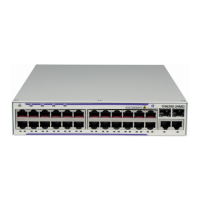The CLI Command Prompt
Page 30 7210 SAS M, T, X, R6 Basic System Configuration Guide
The CLI Command Prompt
By default, the CLI command prompt indicates the device being accessed and the current CLI
context. For example, the prompt: A:ALA-1>config>router>if# indicates the active context, the
user is on the device with hostname ALA-1 in the configure>router>interface context. In the
prompt, the separator used between contexts is the “
>
”
symbol.
At the end of the prompt, there is either a pound sign (“
#
”
)
or a dollar sign (“
$
”
)
. A “
#
” at the end
of the prompt indicates the context is an existing context. A “
$
” at the end of the prompt indicates
the context has been newly created. New contexts are newly created for logical entities when the
user first navigates into the context.
Since there can be a large number of sublevels in the CLI, the environment command reduced-
prompt
no of nodes in prompt allows the user to control the number of levels displayed in the
prompt.
All special characters (#, $, etc.) must be enclosed within double quotes, otherwise
it is seen as a
comment character and all characters on the command line following the # are ignored.
For example:
*A:ALU-7210>config>router# interface "primary#1"
When changes are made to the configuration file a “*” appears in the prompt string (
*A:ALU-
7210)
indicating that the changes have not been saved. When an admin save command is
executed the “*” disappears. This behavior is controlled in the saved-ind-prompt command in the
environment context.

